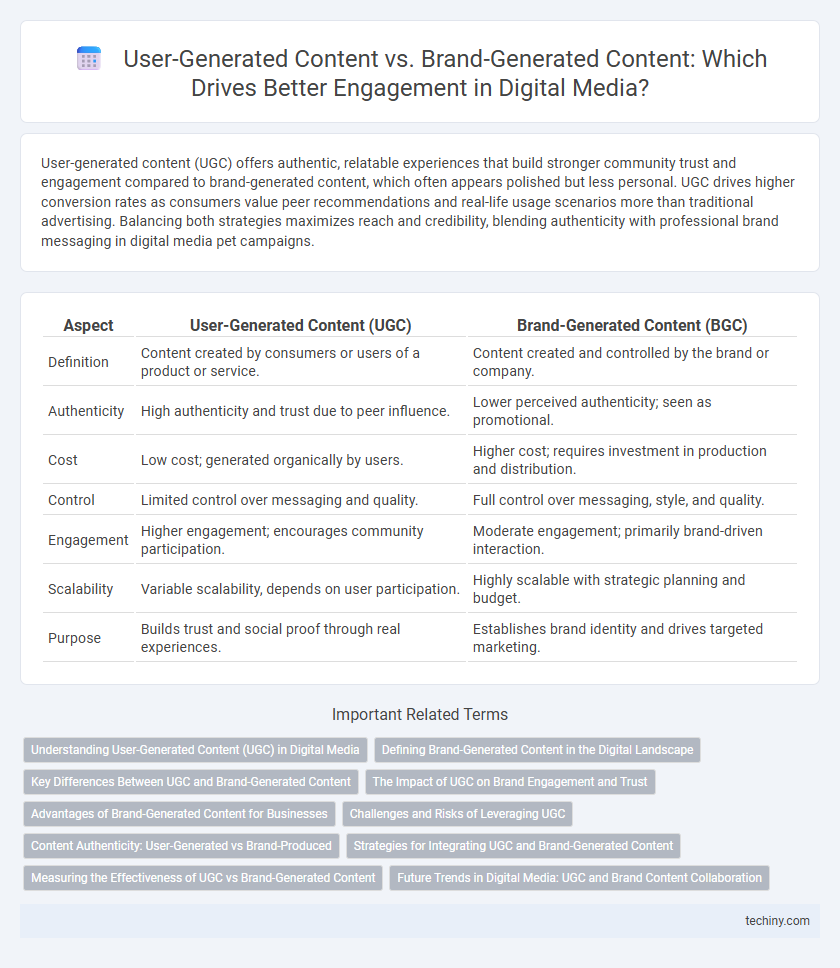User-generated content (UGC) offers authentic, relatable experiences that build stronger community trust and engagement compared to brand-generated content, which often appears polished but less personal. UGC drives higher conversion rates as consumers value peer recommendations and real-life usage scenarios more than traditional advertising. Balancing both strategies maximizes reach and credibility, blending authenticity with professional brand messaging in digital media pet campaigns.
Table of Comparison
| Aspect | User-Generated Content (UGC) | Brand-Generated Content (BGC) |
|---|---|---|
| Definition | Content created by consumers or users of a product or service. | Content created and controlled by the brand or company. |
| Authenticity | High authenticity and trust due to peer influence. | Lower perceived authenticity; seen as promotional. |
| Cost | Low cost; generated organically by users. | Higher cost; requires investment in production and distribution. |
| Control | Limited control over messaging and quality. | Full control over messaging, style, and quality. |
| Engagement | Higher engagement; encourages community participation. | Moderate engagement; primarily brand-driven interaction. |
| Scalability | Variable scalability, depends on user participation. | Highly scalable with strategic planning and budget. |
| Purpose | Builds trust and social proof through real experiences. | Establishes brand identity and drives targeted marketing. |
Understanding User-Generated Content (UGC) in Digital Media
User-Generated Content (UGC) in digital media refers to authentic, consumer-created materials such as reviews, photos, and videos that enhance brand credibility and engagement. Studies show UGC increases conversion rates by up to 7 times compared to brand-generated content, driven by trust and relatability. Platforms like Instagram, TikTok, and YouTube serve as crucial channels where UGC fuels organic reach and amplifies digital marketing effectiveness.
Defining Brand-Generated Content in the Digital Landscape
Brand-generated content refers to digital materials created and distributed by companies to promote their products, services, or values, designed to engage target audiences through curated messaging and professional production. This content spans various formats including blogs, videos, social media posts, and advertisements, all strategically crafted to shape brand identity and drive consumer action. In the digital landscape, brand-generated content leverages analytics and SEO optimization to maximize reach and influence within competitive online environments.
Key Differences Between UGC and Brand-Generated Content
User-Generated Content (UGC) is created by consumers and reflects authentic experiences, often enhancing trust and engagement, while Brand-Generated Content is produced by companies to strategically promote products and control messaging. UGC typically thrives on platforms like social media due to its organic nature, whereas Brand-Generated Content utilizes planned campaigns across multiple digital channels. The key difference lies in authenticity versus control, with UGC driving peer influence and Brand-Generated Content driving consistent brand identity.
The Impact of UGC on Brand Engagement and Trust
User-generated content (UGC) significantly boosts brand engagement by fostering authentic interactions and creating a community-driven atmosphere. Consumers perceive UGC as more trustworthy than brand-generated content, leading to higher conversion rates and increased brand loyalty. Studies show that brands featuring UGC on their platforms experience up to a 28% increase in engagement and a 20% growth in trust metrics.
Advantages of Brand-Generated Content for Businesses
Brand-generated content offers businesses full control over messaging, ensuring consistent brand voice and quality across all platforms. It facilitates targeted campaigns that drive conversions through strategic storytelling and professional production values. By leveraging brand-generated content, companies can establish authority, enhance brand recognition, and effectively manage customer perceptions.
Challenges and Risks of Leveraging UGC
User-generated content (UGC) poses significant challenges including inconsistent brand messaging, potential legal risks from copyright infringement, and the need for rigorous moderation to prevent inappropriate or harmful material. Brands must navigate unpredictable quality and authenticity issues while ensuring compliance with advertising regulations to maintain trust and reputation. Effective UGC management requires advanced content review tools and clear guidelines to mitigate risks and optimize engagement.
Content Authenticity: User-Generated vs Brand-Produced
User-generated content (UGC) offers authentic, relatable experiences that build trust and engagement among digital audiences, contrasting with brand-generated content's polished, strategic messages designed for consistent brand positioning. UGC reflects genuine consumer opinions and organic storytelling, increasing perceived credibility and resonance in social media campaigns. Brands leveraging UGC can enhance authenticity perception while maintaining control over the overall marketing narrative.
Strategies for Integrating UGC and Brand-Generated Content
Effective strategies for integrating User-Generated Content (UGC) and brand-generated content include leveraging UGC to build trust and authenticity while maintaining brand consistency through professional messaging. Brands can create campaigns encouraging customers to share experiences, then curate and blend these posts with official content across social media platforms and websites. Utilizing analytics tools to measure engagement and sentiment helps optimize the balance between organic UGC and controlled brand narratives for maximum impact.
Measuring the Effectiveness of UGC vs Brand-Generated Content
User-Generated Content (UGC) often demonstrates higher engagement rates, with studies showing up to 28% more interaction compared to Brand-Generated Content (BGC), making metrics like likes, shares, and comments crucial indicators of effectiveness. Conversion rates for UGC can outperform traditional BGC by fostering authenticity and trust, which enhances consumer decision-making processes. Analyzing sentiment, reach, and engagement cost per acquisition (CPA) enables marketers to measure ROI accurately between UGC and BGC campaigns.
Future Trends in Digital Media: UGC and Brand Content Collaboration
User-generated content (UGC) is increasingly integrated with brand-generated content to create authentic digital campaigns, driving higher engagement and trust among audiences. Emerging technologies like AI-powered content curation and augmented reality experiences enhance collaborative storytelling, enabling brands to leverage consumer creativity while maintaining strategic messaging. Future digital media trends emphasize hybrid content models where brands and users co-create immersive, personalized narratives that boost brand loyalty and foster community participation.
User-Generated Content vs Brand-Generated Content Infographic

 techiny.com
techiny.com